► Finally – hot hatches take on SUV equivalents
► New Kona N battles its closest rival: the Puma ST
► Can they really usurp the Fiesta ST and i20N?
Is the performance crossover the future of the hot hatch? The world’s gone SUV mad, after all, uprooting no end of traditional norms in the world’s car markets and pushing car makers to think up more and more derivatives. To the point that, now, the classic hot hatch is under threat. Can a hot crossover really be as fun? We’ve brought along Hyundai’s new Kona N to face the Ford Puma ST – its closest rival – and their hot hatch equivalents.
Pre-flight briefing: Hyundai Kona N
Why is it here?
It’s the first crossover to get the N treatment. Aimed at keen drivers with families, it’s skewed slightly more towards long-distance comfort than the i20N and i30N while still being track-capable.
Any clever stuff?
It uses an electronically controlled differential lock, hydraulically actuated by an electric pump. Sole gearbox option is an eight-speed wet dual-clutch gearbox with a creep mode that can be switched on to satisfy drivers used to torque converters. The engine is a development of the 2.0-litre unit familiar from the i30N, with a very flat torque curve and a 276bhp peak. And there’s a rorty noise thanks to switchable exhaust flaps.
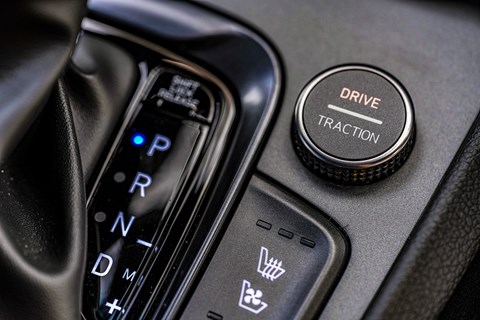
Which version is this?
There’s only one Kona N. All get 19in wheels, heated steering wheel, suede and leather seats, HUD and adaptive dampers.
Read our Hyundai Kona N review
Pre-flight briefing: Ford Puma ST
Why is it here?
The Puma packs less firepower than the Kona N but it’s a natural rival. It has the same power output as the Fiesta ST at 197bhp but a lift in torque to 235lb ft.

Any clever stuff?
Engine is the 1.5-litre turbo triple from the Fiesta ST. Unlike regular Pumas there’s no mild-hybrid system, but the engine can deactivate one of its cylinders under low load, making this a two-cylinder SUV some of the time – and one with the option of a full mechanical limited-slip diff. There’s torque vectoring too, helping to tighten the Puma’s line in corners, and the suspension gains new springs, anti-roll bars and a vastly stiffened torsion beam at the rear.
Which version is this?
Just the one trim available for the Puma ST. Our test car has the Performance Pack, which includes the diff, shift lights and launch control software.
Read our Ford Puma ST review
Pre-flight briefing: Hyundai i20N
Why is it here?
Because it’s a cracking hot hatch, and good enough to be a credible alternative to the Fiesta ST. It’s also a great benchmark for the Kona N, which seeks to upscale that attitude into a family car.
Any clever stuff?
Mechanical limited-slip diff does a great job of putting the power and torque down with very little in the way of torque steer. Automatic throttle-blip on downshifts is smooth as you like, and you can switch it off if you like to heel and toe. The 1.6-litre four-cylinder engine punches well above its capacity with 202lb ft. It’s a new unit with a high-pressure 350bar direct injection system.

Which version is this?
There’s only one model, with the options list limited to paint choices, contrasting roof colours and a stereo upgrade. This one’s only extra is the Dragon Red paint. There’s a 20-week waiting list for any i20N as we write.
Read our i20N review
Pre-flight briefing: Ford Fiesta ST
Why is it here?
Today’s best small hot hatch. The Puma shares plenty with it, including its engine – can it also share the same irrepressible sense of fun?
Any clever stuff?
Buy the optional Performance Pack and you get a mechanical limited-slip diff that makes a big difference to traction and handling. The regular ST’s suspension is pretty smart; curved ‘force vectoring’ springs help control rear wheel placement. The Puma gets them too.
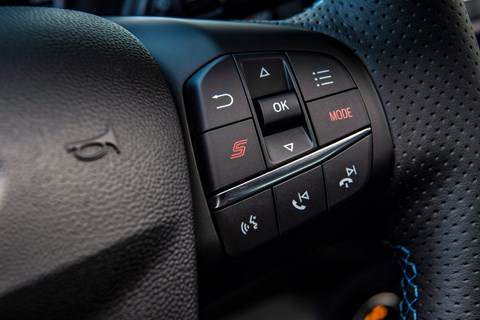
Which version is this?
The ST Edition, which sounds like it’s missing a word, but isn’t. It has manually adjustable coilover suspension, special paint and wheels, and a Sport button on the wheel. All 300 of the UK’s Editions have been sold. No matter: the regular ST2 and ST3 versions are spectacular and the suspension is available to buy separately if you’re really keen.
Read our Ford Fiesta ST review
Two up, two down
This is a stretch of road I’ve driven countless times before, in hundreds of different cars. Just down the road from CAR HQ, an off-camber, right-angled right-hander transitions into a curling-back-on-itself descending left-hand spiral. (My imaginary pace notes read ’90 right over crest, don’t cut, into three left.’ Depending on the time of day, I might add ‘Two left into Starbucks’ further up the road.)
Earlier this morning in CAR’s Hyundai i20N long-term test car I couldn’t help letting out an involuntary chuckle of glee, flicking the gearlever through the gate almost as fast as my hand could move as the burly little 1.6-litre engine’s revs blipped upwards with every downshift (I hadn’t had enough caffeine yet and decided to leave the automatic rev-matching mode on).
Now I’m back on the same road in another N car: same button-clad steering wheel, same rasping exhaust tone, same ability to wave its inside rear wheel in the air. The same, but different. For a start, I’m sat a good chunk higher. To the right of the steering wheel there’s a button for Hill Descent Control, as featured on serious off-roaders. And, within the drive modes menu, there are traction control settings for snow, mud and sand. Hyundai’s latest N car is not a hot hatch but a hot crossover.
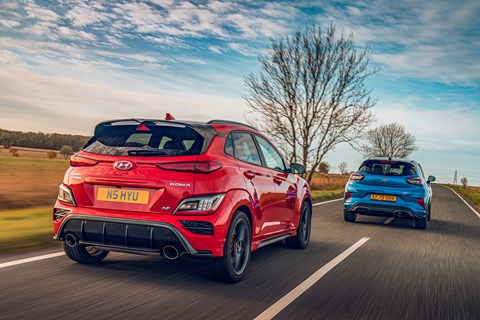
Inevitably, of course: the crossover is part hatchback, part SUV and all-over sales success. (According to data from the UK’s Society of Motor Manufacturers and Traders, crossover and SUV sales have increased by 150 per cent over the last 10 years; supermini sales have dropped by a quarter over the same period.)
This is a breed of car it’s easy to be sniffy about if you’re a purist. Why buy a car that looks a bit like a 4×4 but is extremely unlikely to ever go off-road? Why sit higher when cars handle better if the weight’s lower down? And as for the souped-up sub-genre of performance crossovers – VW T-Roc R, Cupra Ateca, BMW’s XM models et al – why, isn’t that the worst of both worlds? All the dynamic drawbacks of being high and heavy, without being able to cope with a muddy field much better than a regular car thanks to lower ground clearance and lower-profile, fatter tyres. Wouldn’t you be better off with a proper hot hatch, or a proper off-roader?
VW T-Roc R vs rivals
But then… I ride a heavier mountain bike into town more often than I do a lighter road bike, because it feels more comfortable to sit upright, I feel less vulnerable to potholes and it’s easier to bump up and down kerbs if I need to. I haven’t stepped on a skateboard in the last decade but I still buy skateboarding trainers, because they’re comfortable, I like the way they look and, well, lots of other people buy them too so they must be a good choice. Glass house, stones, and all that.
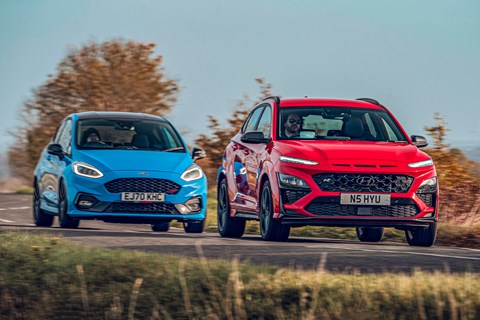
So this is a test within a test: in the main plotline, the new Hyundai Kona N faces off against the Ford Puma ST. And as a sub-plot, we’ve brought along a smaller, trad hot hatch version of each: the i20N and the Ford Fiesta ST. Do the hatches really feel markedly nimbler than their taller siblings? And if they do, does that really make them more fun? Are the mini-SUVs markedly more practical? Is it time to reset our parameters, or do the purists have a point?
While the Puma can claim to be mechanically a bigger version of the Fiesta, the Kona doesn’t use the same underpinnings as the i20 but instead sits on its own, separate platform, designed to cater for all-wheel drive and EV power too (in the actually-quite-excellent Kona Electric). The Kona N, however, is front-wheel drive and shares its rorty 2.0-litre, 276bhp four-cylinder turbo with the i30N. It’s paired with the eight-speed dual-clutch auto that’s an option in the i30N but the only available transmission in the Kona N.
Thump closed a big door with a curiously tiny doorbin, which is not ideal for a family car, and you find yourself in the best interior in this test. The Kona’s suede/leather seats cradle the small of your back nicely, and they’re easier to clamber over than the Puma ST’s mountainous Recaro bolsters. A head-up display is standard, along with heated rear seats, and heated and cooled front seats. It’s the most upmarket-feeling car here but it should be – it costs nearly £40k, or the best part of £10k more than the Puma. In exchange you get considerably more power and performance, too.
It feels easily the fastest of the four cars here, and that’s borne out by the figures: 79bhp and 54lb ft more than the Puma and a full second quicker to 62mph than the Fiesta. This is a seriously quick car. And a serious-feeling one, too. Befitting its higher price, it’s the only car here with adaptive dampers – but even in their most pliant mode, the ride is uncompromisingly (or compromisingly) firm, like its smaller N stablemates. Even on dual carriageways it’s a little clod-footed in Normal mode; dial the dampers up to Sport+, and it’s borderline undriveable. It can bounce clean off a really bumpy road surface, finding fresh air under its 19-inch Pirellis.
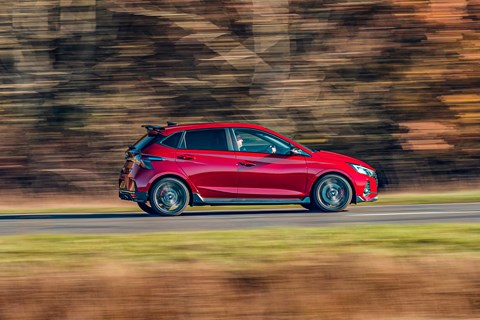
Its firm, four-square stance makes it feel purposeful but also a little leaden compared with the i20N. You won’t be gobsmacked to hear that the Kona is more lazy in its responses, and with a thicker layer of insulation between you and the steering. When I tip it into that same sequence of corners where we came in at the start of this story, there’s an extra heft and slowness to the car’s movement, and it pushes into understeer more readily. This time the i20N’s in my mirrors, and I’m sure CAR’s Alan Taylor-Jones is having a shade more fun behind its wheel than I am in the Kona.
That’s not to say I’m not enjoying myself, though. Nor that the Kona N doesn’t handle very well indeed. Its eagerness to change direction is impressive for a heavy beast (1510kg versus 1283kg for the Puma, 1190kg for the i20N and 1262kg for the Fiesta) and it can do a nice line in lift-off oversteer if you give it a bung.
You can sit really loftily if you wish, in a way that feels oddly similar feel to a Range Rover’s ‘Command’ driving position. Equally, you can sink into the car like Ewan McGregor’s Renton into the carpet in Trainspotting and sit right within the body like a Touring Car racer. Your hands meet the exact same wheel as the i20N but with one difference: since the Kona N is auto-only, the red button that would toggle automatic rev-matching for downshifts in the i20 instead reads ‘NGS’ for, ahem, N Grin Shift.
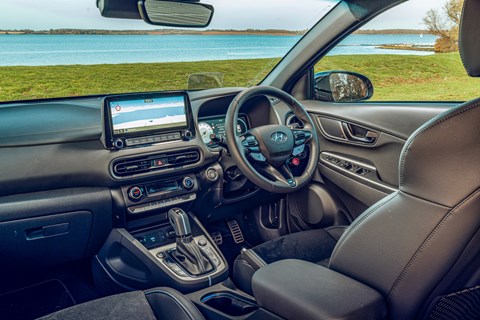
Press it to re-map the transmission and engine for maximum torque and turbo boost for 20 seconds – the better to execute an overtake, blat up a slip road or enjoy a sequence of corners. A brightly coloured timer counts down on the dashboard and turns red for the final few seconds, which makes you feel a bit under pressure to make the most of it, frankly.
There are the same N shortcut buttons on the steering wheel, with which you can access all-out N mode or toggle your own combo of settings for engine response, steering weight, suspension jiggliness and the aggressiveness of the electronically controlled differential lock. The latter can be quite hectoring, tugging at the steering if you pull out of junctions smartly. But it helps the Kona N fire itself out of corners at a rate of knots, even if you can’t help but feel you’re giving the front tyres a hard time, every time.
The dual-clutch transmission does a perfectly decent job: responsive on the paddles and smooth in auto mode. Flick the N mode switch and the head-up display gives you a mid-air revcounter and gear indicator, the better to keep your eyes on the road ahead. Perhaps a manual gearbox would involve you a touch more in the driving experience. But for me the higher hip point and greater mass do more to remove the driver from the process than the transmission.
An automatic suits the Kona’s remit; Hyundai expects Kona N customers to cover bigger miles than i30N and i20N owners. That said, there’s a fair bit of road noise on the motorway, and together with the firm ride it’s not the most relaxing car to cover ground in. On the whole I’d rather do a long journey in the Kona than the i20, but the difference isn’t as marked as I’d expected.
Nor is there that big a gap between the Hyundais in terms of practicality. Sitting behind my own driving position in the Kona I actually have a smidge less legroom than I do in the i20. Headroom is just about okay for my long-legged, short-bodied 5ft 10in frame, with the cant rail a touch closer to the side of my head than I’d like, although it’s better than in the i20.
Whereas the hatches have a step down to the boot floor, you can have something approaching a flat load bay in the Kona with the rear seats folded down. But compared to some estate cars, the tailgate aperture is rounded and less accessible.
There’s a huge transmission tunnel console moulding and yet it has unusable cupholders, for cups at least – one is too big to hold my water bottle, the other too small. In the grand scheme of things, the Kona cabin’s not hugely roomier than the i20’s, although it would doubtless be easier to reach in and extract a child from a child seat in the higher rear seats, via the larger rear doors. And the i20N has just as many USB ports as the more family-orientated Kona.
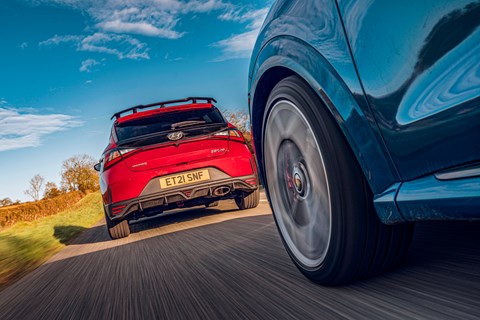
Let’s switch to the Puma. It’s packed with just as much kit as the hatches, and almost as much as the Kona: wireless phone charging, heated seats and steering wheel, parking sensors – but it’s all in a much cheaper-feeling wrapper. The tough plastics and ho-hum design look low-rent in the Fiesta, but the fixtures and fittings feel all the more so in the setting of a larger car.
Ford’s proclivity for putting LEDs in its SUVs’ cupholders makes a plastic drinks bottle light up like a beacon at night, which is a touch distracting. So is the instrument panel, which is a bright shade of blue in Normal mode, turquoise in Eco and an easier-on-the-retinas black in Track mode (which also switches off the stability control).
If you crank the seat right down to the floor in the Puma, it’s actually not far off the hip point of the Fiesta – although that might say more about how loftily high the seating position is set in the Fiesta than how low it can be in the Puma. But there’s a good range of adjustment, even though I can’t get quite as comfy behind the wheel as I can in the Kona. The seats are heavily bolstered Recaros as per the Fiesta, and if you lift the seat a touch higher in the Puma for a better view they dig into your back in an overly familiar bear-hug. And a big thumbs-up for the Puma’s Megabox, a drainable 80-litre wine cellar (or muddy boot holder, or pretty much anything you like) under the two-level boot’s ground floor, giving it the edge on luggage-carrying capability.
Forget the trim and the ergonomics, though, because the Puma ST’s ace card is the way it drives. This one has the optional Performance Pack, which brings a mechanical limited-slip diff and launch-control software, just as it does in the Fiesta ST. The steering is similarly sharp, and its sheer speed of response takes a little adjusting to at first. The shortfall in power less so; if Ford was ever tempted to squeeze a bigger engine into the Puma ST to compete with pricier hot crossovers nudging 300bhp such as the Cupra Ateca, it did the right thing in sticking with the Fiesta ST’s boisterous three-cylinder engine.
If it lacks outright power at 197bhp, it makes up for it with its sharp throttle response and memorable character. Its engine and gearshift (a short-throw six-speed manual) are as eager as its handling. It’s lighter on its feet than the Kona in more ways than one, with less tendency to understeer and more opportunity to tighten and adjust its line with a fraction off, or on, the throttle pedal.
The ride is rowdy but less so than the Kona; where that car is aggressively firm, the Puma’s quietly fidgety. There’s a constant patter of background suspension noise, even on the motorway. It lends the car a restless feel, and a long journey could be more tiring as a result. But it’s no deal-breaker.
The Puma has a touch less legroom than the Kona, and similar headroom above and to the side – its sloping roofline doesn’t cut as much head space as it looks from the outside. The measurable differences aren’t massive, but the overall feel is lighter and airier than either of the hatchbacks, and there’s a clear benefit for luggage and back-seat passengers.
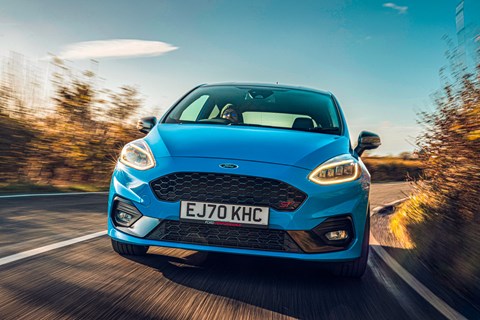
Transfer into the Fiesta and all those happy memories of previous hot Fords come flooding back. This one’s the limited-run Edition, which has manually adjustable coilover suspension. That gives the car silky body control on bumpy B-roads for a beautifully fluid ride (far better than the i20N), but makes me feel like I’m sat inside a cocktail shaker on the motorway, finding bumps I didn’t even know existed. Curious; worth playing with the settings. But the main thing to know is, this is still one of the most fun cars on sale today at any price.
The Jekyll, Hyde and Hyde-in-a-really-angry-mood driving modes are a big part of the i20N’s character and the Fiesta has switchable modes too, but it’s so scampish even in its default setting that you’re less inclined to toggle between the modes. The engine has so much more urgency and character than the Hyundai’s. The i20N’s punches harder when it gets going but the Fiesta’s feels more eager to pick up, which is more important for enjoyment on the road. The rapidity with which it gains and loses revs makes it feel more throttle-adjustable too. This is surely the most tail-happy Ford since the Mk2 Escort but it somehow feels entirely safe too; the merest tweak of the steering wheel and the Fiesta pivots sideways. But it’s entirely controllable and never alarming. Just a lot of fun. Within a few minutes I’m wearing a bigger grin than I have in weeks. And, it has to be said, a broader one than within either of the two crossovers.
Second opinion: Richard Kilpatrick, consumer editor, Parkers
The Puma ST reminds me of a Mk2 VW Golf GTI, for its solid feel and ability to entertain or handle a long drive with equal competence. By comparison the Kona N feels like a car that’s been modified to be fun rather than designed that way, with its raucous modes, bouncy suspension, poor visibility compared to the Puma or Fiesta, but lots of pops, bangs and fancy dashboard graphics. It’s undeniably very quick for what it is, but it’s not particularly rewarding or pleasant. What unites all four of these cars is that they’re in the GTI tradition of being rapid versions of the cars regular families buy, as distinct from the madness of the Audi RS3.

Second opinion: Alan Taylor-Jones, new cars editor, Bauer Automotive
Spending the day flitting between the pairs of STs and Ns revealed two very different approaches. While Hyundai seems to favour outright cornering speed on smooth surfaces, Ford’s efforts are far happier on regular roads. The i20 and especially the Kona in full N mode are far more upset by pimples and cambers, making the latter especially palm-moistening on a ditch-lined Fenland road. The STs are better at absorbing bumps, with the Fiesta ST’s trick dampers proving particularly good at controlling excess movements. The Fords also steer more sweetly and have a more playful handling balance at sane speeds.
Ford vs Hyundai, crossover vs hot hatch: the final reckoning
The hatches are better to drive than the SUVs. You don’t say, Sherlock. But we didn’t want to just assume that to be the case, so we drove these cars back to back on the same roads, hopping from one to another to pin down precisely where the real differences reside. But, yes, it’s pretty much what you’d expect: the smaller cars’ handling is more polished, changes of direction are nimbler, and sitting lower means you’re thrown around less. On the flipside, the crossovers’ higher vantage point enables you to see over the top of hedgerows and plot further ahead than in the Fiesta or the i20N.
Point to point, I’d wager the Kona N could cover ground quicker than any car here. And it is genuinely fun to drive. But although entertaining, thanks to its power and thrillingly quick acceleration, it is also the least satisfying driver’s car here. It feels like a car that’s been forced to go faster than it really cares to, rather than a performance car engineered that way from the ground up (despite thorough work by Hyundai’s N division, including extra welding points added to the body).
Although the Kona N has been engineered to cope with the occasional trackday (and I suspect it’s quick enough to give a lot of cars a big surprise), you’re conscious you’re heating up the brakes more quickly than you do in the i20N, and taking more out of the bigger tyres.
The Puma is slower but ultimately more satisfying. It’s more responsive, less inert and more playful. That same eagerness, with intensely responsive steering and pattery ride, also makes it a touch less easy to live with than a mainstream crossover.
And the Puma ST is still not quite as entertaining as a traditional hot hatchback. If these cars were ranked purely according to practicality and liveability, the Puma would just shade the Kona, and the Fiesta would bring up the rear. But each of these cars is marketed as being fun to drive, first and foremost, and that’s how we’ve ranked them here.
In their private battle, the i20N is easier to live with than the Fiesta, with a vastly more pleasant interior and a more grown-up character. But the Ford’s still the more exciting car to steer. It really feels like a classic hot hatch we’ll be remembering 30 years from now in the same way we do the Peugeot 205 GTI. I’m not convinced the Puma ST or Kona N will be remembered in the same way. But they prove that it’s still possible to create great driver’s cars as rooflines and hip points rise, and that’s cause for celebration.
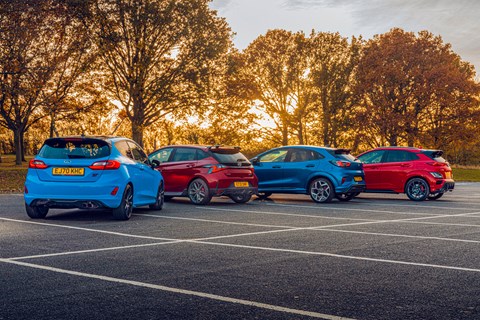
Ford vs Hyundai, crossover vs hot hatch: verdict
First place
Ford Fiesta ST
Still the biggest giggle on four wheels
Second place
Hyundai i20N
More mature and easier to live with than the Fiesta but not quite as much fun
Third place
Ford Puma ST
Seventy per cent as enjoyable to drive as the Fiesta – which still makes it more rewarding than most cars on the road
Fourth place
Hyundai Kona N
Riotously fast and the nicest interior here, but the least polished car dynamically
Read more CAR comparison tests here